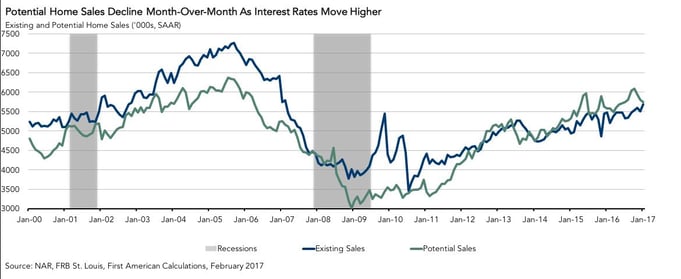February 2017 Potential Home Sales
For the month of February, First American updated its proprietary Potential Home Sales model to show that:
- Potential existing-home sales decreased to a 5.7 million seasonally adjusted, annualized rate (SAAR).
- This represents an 89.8 percent increase from the market potential low point reached in December 2008.
- In February, the market potential for existing-home sales fell by 0.5 percent compared with a month ago, a decline of 28,000 (SAAR) sales.
- Currently, potential existing-home sales is 658,000 (SAAR) or 11.5 percent below the pre-recession peak of market potential, which occurred in July 2005.
Market Performance Gap
- The market for existing-home sales is underperforming its potential by 2.5 percent or an estimated 142,000 (SAAR) of sales,
- Last month’s revised underperformance gap was 4.5 percent or 260,000 (SAAR) sales.
Millennial First-Time Homebuyer Demand Remains Strong Despite Sellers’ Market
“Steady income and job growth combined with increased building permit activity has increased the market potential for home sales on an annual basis,” said Mark Fleming, chief economist at First American. “Demand from Millennials and first-time homebuyers remains robust despite the strong spring sellers’ market and rising rates, resulting in a shrinking underperformance gap, as the market aligns with its potential.”

Chief Economist Analysis Highlights
- The housing market’s potential for existing-home sales grew 2.4 percent over the past 12 months, despite increasing interest rates. Strong building permit activity and an increasing number of people returning to the workforce helped to increase market potential.
- Limited supply, which remained steady at 3.6 months, continues to put upward pressure on prices, as current homeowners are caught in a “matching trap,” where they are reluctant to list their homes for sale out of concern they will not find a home to buy.
- Nevertheless, the outlook for further increases in market potential remains bullish, as strong job and income growth, and increasing demand from Millennials and first-time home buyers in general, bode well for the housing market.
- Additionally, according to the most recent First American Real Estate Sentiment Index, there is increasing confidence among real estate professionals that buyer demand will remain strong, even if rates exceed 5 percent.
What Insight Does the Potential Home Sales Model Reveal?
When considering the right time to buy or sell a home, an important factor in the decision should be the market’s overall health, which is largely a function of supply and demand. Knowing how close the market is to a healthy level of activity can help consumers determine if it is a good time to buy or sell, and what might happen to the market in the future. That’s difficult to assess when looking at the number of homes sold at a particular point in time without understanding the health of the market at that time. Historical context is critically important. Our potential home sales model measures what we believe a healthy market level of home sales should be based on the economic, demographic, and housing market environments.
About the Potential Home Sales Model
Potential home sales measures existing-homes sales, which include single-family homes, townhomes, condominiums and co-ops on a seasonally adjusted annualized rate based on the historical relationship between existing-home sales and U.S. population demographic data, income and labor market conditions in the U.S. economy, price trends in the U.S. housing market, and conditions in the financial market. When the actual level of existing-home sales are significantly above potential home sales the pace of turnover is not supported by market fundamentals and there is an increased likelihood of a market correction. Conversely, seasonally adjusted, annualized rates of actual existing-home sales below the level of potential existing-home sales indicate market turnover is underperforming the rate fundamentally supported by the current conditions. Actual seasonally adjusted, annualized existing-home sales may exceed or fall short of the potential rate of sales for a variety of reasons, including non-traditional market conditions, policy constraints and market participant behavior. Recent potential home sale estimates are subject to revision in order to reflect the most up-to-date information available on the economy, housing market and financial conditions. The Potential Home Sales model is published prior to the National Association of Realtors’ Existing-Home Sales report each month.



